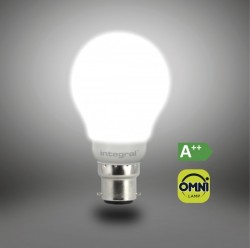The main reason people choose LED light bulbs is because they emit a good quality light, require low wattage (therefore using less energy) and have a long lifespan making them more cost-effective in the long-run. Here are a few things to consider when choosing LED light bulbs:
Efficiency
Manufacturer’s claims vary wildly about the efficiency of LED light bulbs and can often be quite misleading. The simplest way to ensure that you are comparing “like with like” is to look at the efficiency in Lumens per Watt. That is, how much light do you get for each Watt of electricity used? An example is this Crompton Lamps Dimmable LED GLS 5W bulb. It is 5W and gives out 470 lumens. This means it produces the same amount of light as a 40W bulb.
Colour Temperature
LED light bulbs are available in a range of colour temperatures from warm white (2700 or 3000K) up to daylight (6000K and beyond). LED light bulbs with a higher colour temperature do however tend to be slightly more efficient than those with a lower colour temperature so some companies offer these as a way of making their products seem brighter. To replace standard incandescent or halogen lamps, a colour temperature of around 2700K to 3300K is preferred. Some companies use non-standard terms when describing the colour of LED light bulbs such as “natural white” or “office white” which cannot be readily compared with other products. To ensure that you are comparing like with like always check the colour temperature.
Colour rendering
The colour rendering of LED light bulbs varies quite markedly between brands. For some applications this is not particularly important but for ambient lighting it is important to check the quality of light emitted. The LED light bulbs that we offer for ambient lighting all have good colour rendering, comparable to that of a good quality fluorescent tube. Many manufacturers do not however quote a colour rendering index for their LED light bulbs so we are rarely able to quote specific figures.
Heat output
LED light bulbs are cool to the touch unlike other bulbs which can get hot because of the infrared light produced. However, LED light bulbs do produce heat from inside the bulb and should have good heat sinking otherwise there is a risk that the characteristics of the bulb will change.
Rated Life
The one area where LED light bulbs really score highly is in their rated operating life which typically ranges from 20,000 to 50,000 hours. This is 20 to 50 times longer than a typical incandescent lamp so LED light bulbs are ideal for use in areas where maintenance is difficult or long life is important.
Date: July 22, 2014
Tags: guides led light
Efficiency, Colour Temperature, Colour Rendering, Heat Output and Rated Life. Learn what to consider when choosing the right LED bulb for your needs.





[…] Switching to LED light bulbs is an excellent way to save energy and money in the long run. However, if you’re new to LED bulbs, you may not be sure how to install them. In this step-by-step guide, we’ll walk you through the process of installing LED light bulbs. […]